A beer is sometimes jokingly called liquid bread, and that’s not very surprising! They have many similarities. Both are mostly made from a grain, water and a form of fermentation, and in both cases the end result is often a highly enjoyable treat. In Beer & Bread, players will be baking bread and brewing beer. Are you a master brewer or boss baker? Or rather a drunk with a gluten allergy?
Goal
The title of Beer & Bread already strongly hints to what the game is all about: baking bread and brewing beer. Players will do that over six years (rounds) and then it’s time to retire early and enjoy some bread and beer. Players are neighbours, separated only by a stream. Both players have a field with a brewery, a bakery, a warehouse and enough empty space to build upon. In the six years, fertile and dry years consistently alternate. In the fertile years, a successful harvest means there is a wealth of ingredients, and players may literally and figuratively play into each other’s hands by exchanging their cards and (possibly) the ingredients in case of abundance. In the dry years, resources are scarcer and players will keep their cards closer to heart.
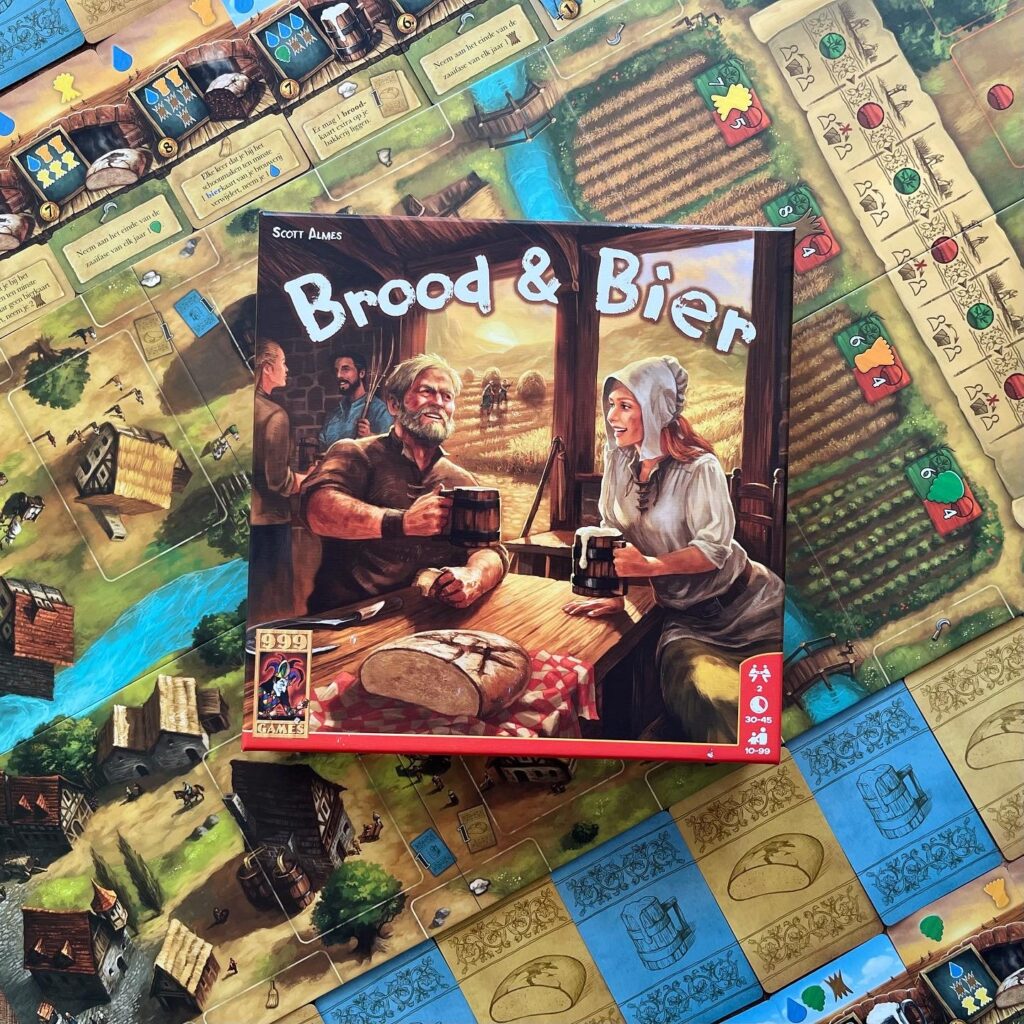
At the end of the sixth year, the scoring follows. Players get points for all their bread and beer and possibly based on their expansions they also get bonus points that count for bread and/or beer. So both goods are scored separately and only the lowest of these two scores is counted first. The player with the highest lowest score wins. That already gives you a push to spread your chances during the game. Well: the necessity to not put all your bread in the same basket or bet on a single barrel. So don’t forget this rule when explaining it to friends!
Setup
Players take a seat on either side of the table. Players then place the (based on the size of the box a larger than expected) board between them in the middle of the table. Next to the game board, they place a shuffled deck containing both bread and beer cards. The back of the cards indicates whether to expect bread or beer. Next to the board, they also place a general supply with all the different ingredients you can make bread and/or beer with (water, wheat, barley, rye and hops). Place the white marker on year 1 and give a random player the mill. In principle, you are now ready to play, but to get the full experience, some more much-needed preparation is required.
Before the game, you need to bake a loaf of bread. Preferably a multigrain sourdough bread or any other suitable bread according to your personal recipe and requirements. Once your bread is ready and is cooling down a bit, you can make a delicious herb butter. Take unsalted butter or a vegan variation at room temperature and chop some fresh parsley, chives and oven roasted garlic very finely and add these to the soft butter along with some black pepper and coarse sea salt. Prepare a basket with some warm slices of bread, the herb butter and some other dips, if necessary. As a final step, pull a cold beer from the fridge and pour it into a matching glass (or mug). When your beer has a nice head of foam, you are ready to play for real.
Gameplay
Each year, players go through four phases that are slightly different in the fertile and dry years. In the sowing phase, ingredients are placed on the fields on the game board. In the fertile years there are more ingredients than in the dry years. The ingredients in the fields are the ingredients available to harvest in that round. In the card phase, players receive cards in hand. During the fertile years, players draw 5 cards from the central pile. During the dry years, they take back in hand the cards they used to harvest in the previous round and replenish until they have five hand cards and also place three cards face-up on the board.
The action phase is the heart of Beer & Bread. With the cards on hand, players take actions. During the fruitful phase, players take turns playing one card each for an action and then pass their remaining cards to the other player. In the dry years, players do not exchange their hand, but can exchange a card with one of the three face-up cards on the board. Players select the card they want to use for an action and which action. Each action card depicts three possible actions: A. harvest and storage (on top), B. production and sale (in the middle) and C. expansion and cleaning (at the bottom). Players choose one of these actions per card.
If they use a card to harvest with, they take pictured ingredients (shown on top of the card) and place them on their storage. Storage space is limited and if players need to store more ingredients than there is space, the abundant ingredients may go to your opponent. Cards used for harvesting are placed in front of the player in question.
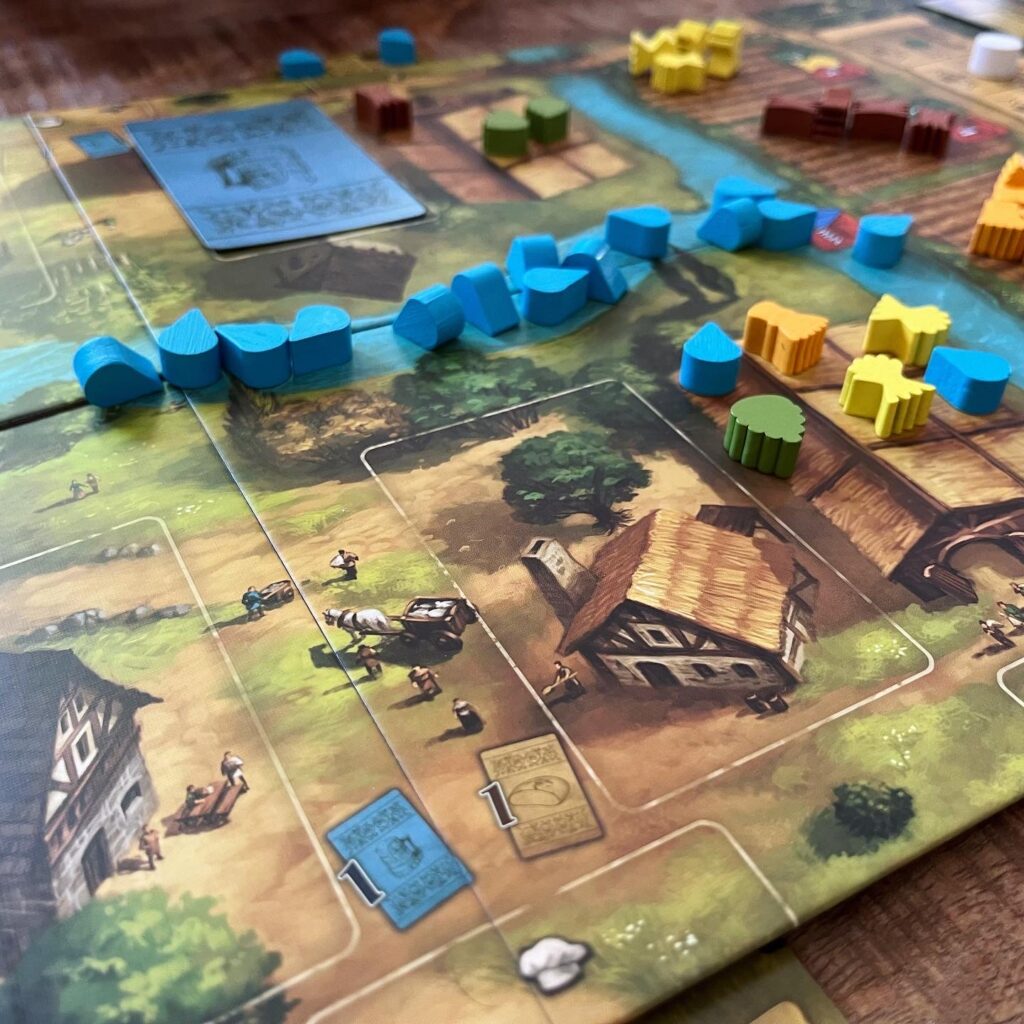
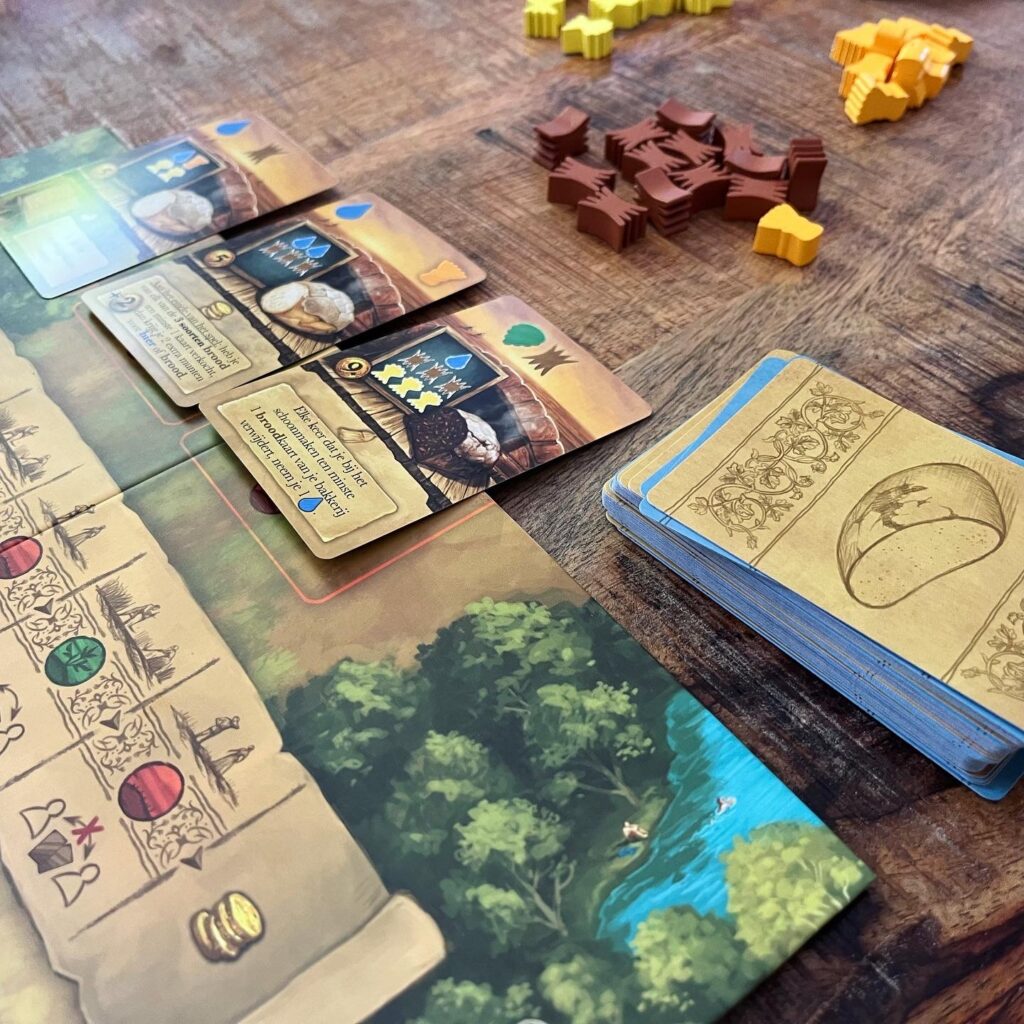
When a player produces and sells, the player must pay the cost on the card by depositing ingredients in the storage depicted in the centre of the card. Bread cards you place on your bakery and beer cards on your brewery. At the beginning of the game, there is only room for 1 card at each spot and cards are discarded when you ‘clean up’. With bread and beer sold, you can earn points at the end of the game.
Symbols are depicted on both sides of the game board. By expanding, players can slide cards under the board on their side. These cards used to build earn bonus points, extra storage, extra space in the bakery and/or brewery, other bonuses and extra actions. If a player has expanded, that player must then clean up: all beer and bread is removed from the bakery and brewery and placed on the player’s closed points pile.
Towards the end of the round, the milling phase takes place. The player with the fewest ingredients in storage gets the mill (and may perform actions first during the next round) and in the dry years, harvest cards and trading cards are discarded. At the end of year 6, scoring takes place.
Verdict
Beer & Bread is by Scott Almes, who you may know mostly from the Claim trick taking games and its many expansions. But Scott is even better known for the games in the Tiny Epic line. So this game author is well versed in providing great gaming experiences with a smaller footprint and manageable game concepts. Beer & Bread is another such game. Indeed, Beer & Bread feels like a heavy eurogame, which usually have reasonably dry/realistic themes, but for just two players and with a modest game duration.
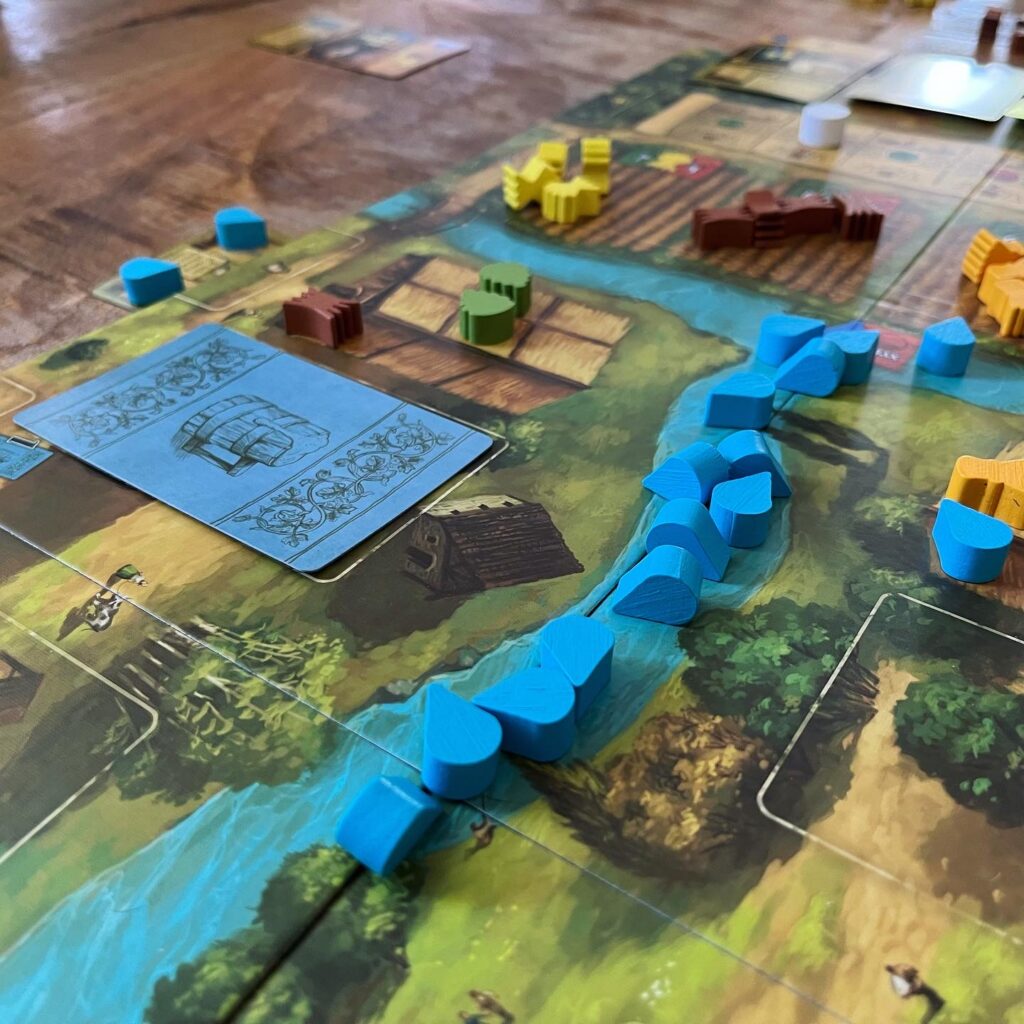
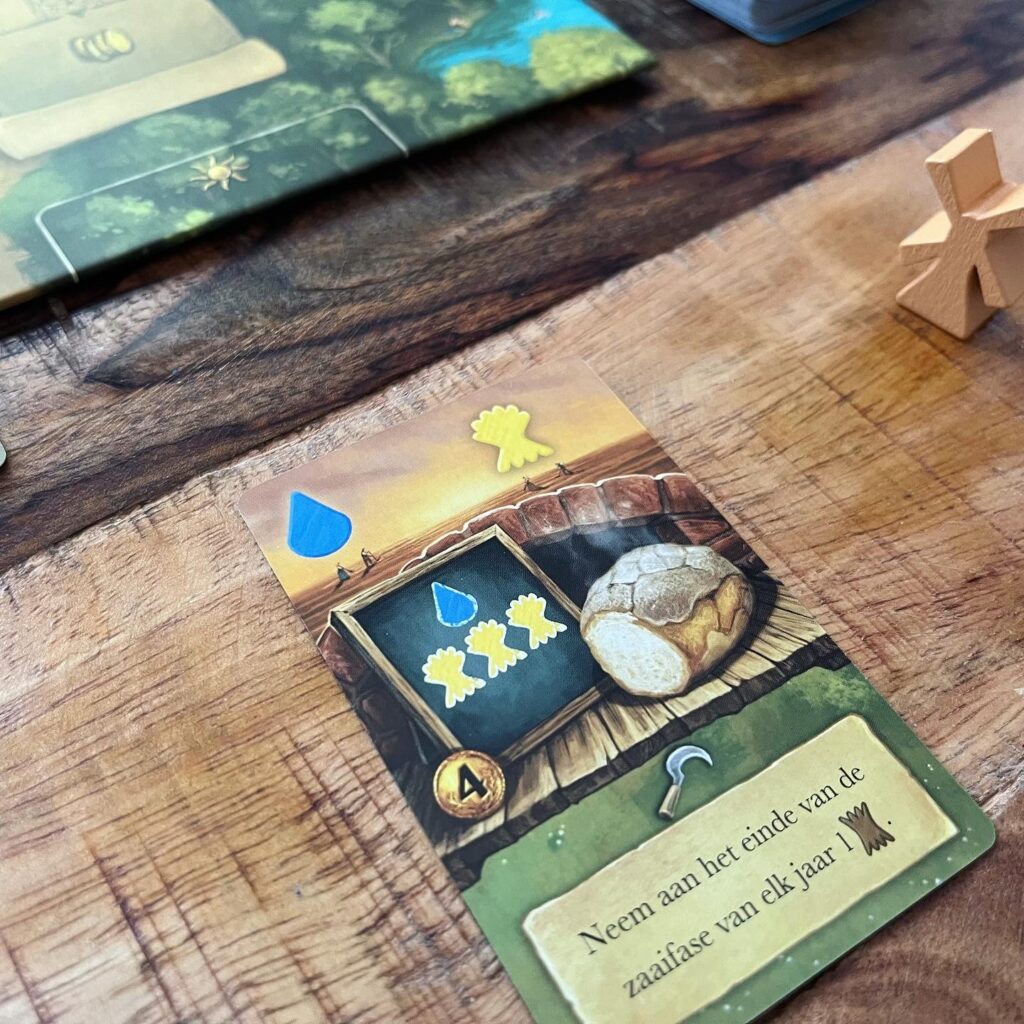
If we compare it to bread, Beer & Bread certainly does not offer a dry gaming experience. Unlike several classic eurogames, Beer & Bread is not stale, but is light, fluffy and has a crispy crust. All the aspects of a heavy eurogame are present, but the gameplay is intuitive, innovative and nice and fast paced. Many good euro games are less well suited to two players, so it is also a relief that Beer & Bread on the contrary, can only be enjoyed by two strategy lovers.
I already described the game as fast paced: each turn you discard a card for an action and there is a choice of three possible actions, but all the cards are unique in the sense that there are different combinations of ingredients, bread/brew types and expansion options. This ensures little down time but often confronts you with difficult but also interesting choices: what do I use a card for and when do I deploy it. Sometimes, on the contrary, you want to keep a card and the harvest action in fertile years offers a solution, because you then get this card back in the following dry year. Keeping cards is difficult in fertile years, by the way, because you pass on the remaining hand cards each time: an extra dilemma that makes the game even more dynamic.
As far as I am concerned, Beer & Bread is highly recommended for fans of two-player strategic games and I expect this game to sell like hot cakes (or breads).




